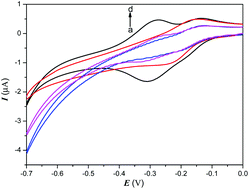Electrochemical DNA sensor for specific detection of picomolar Hg(ii) based on exonuclease III-assisted recycling signal amplification†
Abstract
An ultrasensitive methodology was successfully developed for the quantitative detection of picomolar Hg2+ based on the combination of thymine–Hg2+–thymine (T–Hg2+–T) coordination chemistry and exonuclease III-aided recycling signal amplification. Single-strand probe DNA was immobilized on an Au electrode via an Au–S bond. In the presence of Hg2+, the probe DNA hybridized with the target DNA containing four thymine–thymine (T–T) mismatches via the Hg2+-mediated coordination of T–Hg2+–T base pairs. Then the probe DNA in the DNA duplex was specifically recognized and selectively digested by exonuclease III; in contrast the target DNA was safely dissociated from the DNA duplexes to subsequently hybridize with a new signal probe, leading to target recycling and signal amplification. As a result, the peak current caused by the electrostatic interactions of [Ru(NH3)6]3+ cations with the backbone of the probe DNA decreased by different degrees, corresponding to the Hg2+ concentrations. Under the optimum conditions, the proposed electrochemical DNA biosensor showed a robust detection limit as low as 1 pM (S/N = 3), with a wide linear range from 0.01 to 500 nM and good selectivity. In addition, the proposed method was successfully applied to assay Hg2+ in real environmental samples.


 Please wait while we load your content...
Please wait while we load your content...